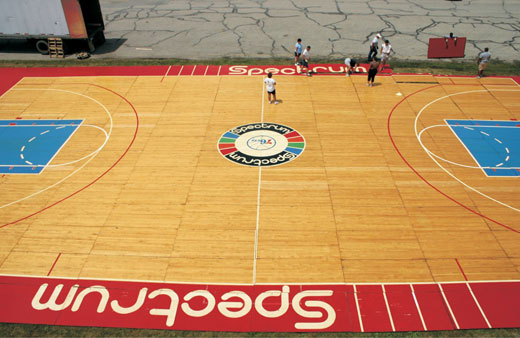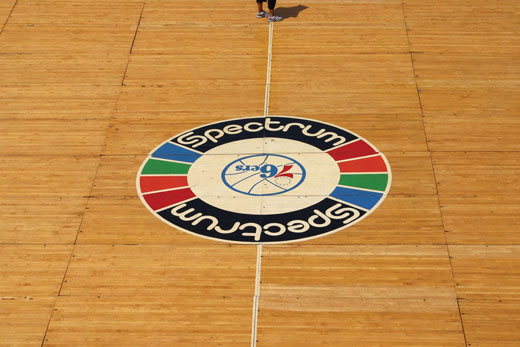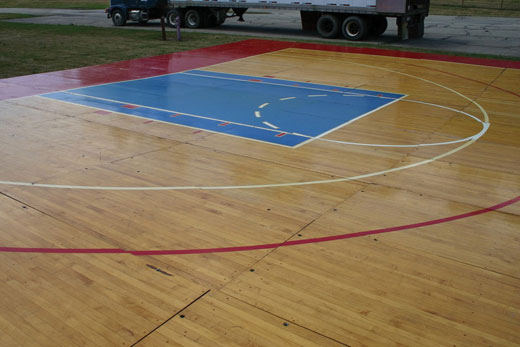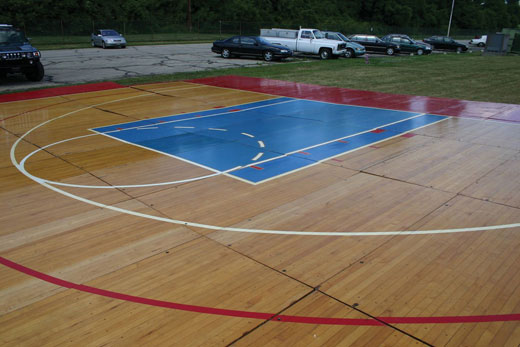Dimensions are an Astonishing 60' x 112' (6,720 sq. ft.)! - Letter of Provenance From Its Current Owner

Over the past 15+ years, Memory Lane has certainly offered the collecting community some of the hobby's most amazing and highly coveted artifacts. Some of these collecting treasures include T206 Honus Wagner's, Babe Ruth Rookie Cards, a plethora of 1952 Topps Mantles, Babe Ruth Game Used bats, a vast number of desirable game-used jerseys for all the major sports, the 1890 Players' League "Northeast Find", a seemingly infinite number of world-class autographs, T206 Ty Cobb's w/a Cobb Ad Back and even the ultra-elusive 1914 Baltimore News Babe Ruth prize for which there are only 10 known examples.
Yet, some 14 years ago in March 2005, our esteemed consign did in fact purchase it along with four other partners from the Troy, Ohio Hobart Arena. This sale was coordinated by the City of Troy, OH. Recreation Board who had originally attained it in November 1982, with its availability based on the Spectrum's decision to replace the original hardwood floor after the 1981/'82 basketball season. After 14+ years of storing it in a climate-controlled warehouse (for safe keeping), the five business partners have ultimately decided to choose Memory Lane to sell their highly-cherished original Philadelphia Spectrum basketball court that still includes all 210 4' x 8' hardwood panels including the classic Philadelphia 76ers center court logo. We are immensely humbled by this distinguished honor and hope that its ultra-fortunate new owner(s) will treasure it in the same manner as our esteemed consignors.
In the fall of 1967, the doors to the newly built Philadelphia Spectrum were opened for the first time, with the primary focus for this new "shrine" being a home for the city's beloved 76ers and Flyers basketball and hockey teams, respectively. The "City of Brotherly Love" placed this facility at the south end of Broad street, the second arena now existing in an area dubbed "South Philadelphia Sports Complex". This remarkable floor is the EXACT basketball court that was affixed to the floor to inaugurate the Philadelphia 76ers 1967'68 season. With a basketball seating capacity of 15,244 (eventually expanded to 18,168), the 76ers christened their new building and thrilled their beloved fan base by posting the finest record in the NBA, winning 62 games against only 20 losses.
This grand achievement was led by the immortal 7'1" center Wilt Chamberlain who captured the MVP that season, with able assistance from small forward Hall of Famer Billy Cunningham and guard Hal Greer who both, like Chamberlain, are members of basketball's illustrious Hall of Fame. In the Conference Semi-Finals, the Sixers would best the N.Y. Knicks in a 6-game series, only to move on and blow a 3-1 series lead against the Bill Russell-led Boston Celtics in the Conference Finals. The "Dr. J" Julius Erving-led Sixers would move on to lose three heart-breaking finals (1976/'77; 1979/'80; 1981'82) with the '81/'82 loss at the hands of Magic Johnson's Los Angeles Lakers.

Spearheaded by the uncanny exploits of Moses Malone and "Dr. J", the Sixers would finally capture an NBA Championship in the 1982/'83 season, only one year after this amazing hardwood floor offering was replaced. Over that 14-year span, nine 76er Hall of Famers graced this court including Chamberlain, Erving, Malone, Cunningham, Greer, Jones, Bailey Howell, McGinnis and Cheeks. This doesn't even include the seemingly infinite number of non-76er basketball legends who dribbled, scored points, blocked shots and performed at a virtually uncanny level including the likes of Jabbar, West, Baylor, Russell, Havlicek, Reed, Frazier, Barry, Maverich, Lanier, Hayes, Bird, Johnson and so many more of the NBA's most renowned all-time greats. One of those noteworthy moments was the iconic Julius Erving "Over & Under" shot that is consistently shown as an NBA "Top 10" all time play!
After their extremely tough defeat at the hand of the Lakers in the Spring of 1982, the Sixers front office decided that the Spectrum's original hardwood floor needed to be replaced. In fact, in a May 4, 1982 Philadelphia Inquirer article, Ernie Thompson (Philly Spectrum's VP of Operations) clearly stated that the hardwood floor is 14-years old and next year they would require a new floor. Synonymous with any aging basketball hardwood floor, it was losing its resiliency and placing serious stress on the hip, knee and ankle joints of the Sixer's players. When first assembled in the opening of the Spectrum in 1967, the depth of the floor measured approximately 7/8". Due to the consistent "sanding down" (and re-applying of polyurethane) over the 1967-1982 timespan, the depth had diminished to approximately 5/8" to ¾", placing additional strain on the player's joints and resulting in numerous injuries that were being attributed to the floor's age. <


Literally speaking, "the time had come" to replace the original floor with a new hardwood surface that, in its inaugural 1982/'83 season, would be company to the Sixers claiming their first NBA Title. The Sixer's front office now needed to decide what to do with the old floor. Via its extensive advertising effort, the front office was contacted by Hobart Foundation based in Troy, Ohio. For promotional purposes, the Troy Hobart Foundation thought it would be an outstanding idea to utilize the floor for their highly regarded Hobart Arena. After coming to terms for a $15,000 final purchase price, they would send an 18-wheeler truck to "Philly" to pick up all 210 floor panels that as previously mentioned weighed a staggering 25,200 lbs! It was in the Hobart Arena that the Spectrum's original hardwood floor would reside for roughly 23 years, with a myriad of the city's patrons enjoying its extensive heritage.
In 2005, the City of Troy, Ohio Recreation Board regrettably opted to sell the old Spectrum floor in an auction format for purposes of raising additional money for their foundation. It was then that a local Pastor from Urbana, Ohio saw an ad detailing the upcoming auction for the Hobart basketball court whereby he immediately contacted one of his close friends regarding its availability. One of our consignors just happened to be that local Pastor's close friend and after discussing the possibility of purchasing it with four additional business partners (one of which being the Pastor himself!), the five individuals decided to bid for the floor in a March 9, 2005 auction sponsored by the Troy Recreation Board. Starting at a $5,000 opening bid, our consigners ultimately won the old Spectrum basketball court, "pulling the trigger" for what they thought was a then extremely equitable sum of $20,176.
Extremely excited, the five business partners' easy task was handing the Troy Hobart Foundation a $20,176 check. Now the hard part... .how do they get the floor transported from Troy, Ohio to their warehouse situated in Urbana, Ohio, some 45 miles away? Utilizing one of their own 18-wheeler trucks, the consignors drove to Troy and via an extremely useful forklift, had the 210 panels (each measuring 4' x 8') loaded onto the truck with the able assistance of the Troy Recreation Department who oversees the Hobart Arena. Coordinating the "load out" was Kenneth E. Siler, Director of Recreation for the Hobart Arena, with the 210 panels occupying approximately 75% of the 18-wheeler truck. Coincidently, Mr. Siler some 14 years later still resides at the Troy Recreation Department.
After arriving at the Urbana warehouse, they did NOT have the use of a forklift, and had to remove all 210 panels by hand (each weighing approximately 120 lbs.), with all five partners, their wives and a hoard of "called upon" friends joining in for this monumental yet fun task. The "fun" notion stems from the fact that the wooden boards were not immediately carried into the warehouse for storage. The new owners decided they would take on the additional monumental chore of assembling the entire basketball court in the super-sized warehouse parking lot! Taking several hours, the numbered panels were affixed into their appropriate position until the entire court was complete.
It should be noted that each wooden board has a panel number (e.g., J1, I1, etc.), with these serial numbers utilized for easy assembling purposes. The entire court was now laid out in an Urbana, Ohio parking lot and the new owners and related family/friends were not going to let this grand opportunity pass them by. As evident from some of our detailed scans, you can see the complete basketball court including the classic Philadelphia 76ers logo. For full disclosure, we are uncertain if this current logo is the EXACT 76ers center circle insignia utilized for the opening of the Spectrum in 1967. While the floorboards utilize for the logo are the same panels, typically with virtually all NBA basketball courts, the center-court logos are consistently repainted/replaced due to the on-going "resurfacing/sanding" issues. Therefore, we can only assume this particular Sixers logo was the last in a line of previously utilized logos.
Once assembled, all of the participants in this immense project excitingly graced the court, with some even pulling out basketballs (brought along for the event) and dribbling them on this miraculous hardwood floor (our website portrays various pictures of the assembled floor in the parking lot). A particular image even depicts one of the five business partner's wives laying down at center court as she basks in the sun after literally collapsing from exhaustion during this momentous event. Now that "playtime" was over, the excruciating task of disassembling the 210 panels and carrying them into the warehouse remained. "One by one", each panel would be carried by two individuals into a specially designated and climate-controlled warehouse room to appropriately preserve this world-class gathering. It is in this room that all floorboards have safely resided for the past 14+ years, with the consignors visiting their prized possession approximately 6 times over that extended period of time.
Simply stated, there aren't enough adjectives in the English language to even attempt to justify the unparalleled stature of this "one of a kind" landmark offering. While we have already touched upon the laundry list of basketball legends who made history on its surface, its unbridled legacy extends far beyond the NBA. Before the Spectrum officially closed its doors forever on October 31, 2009, it had hosted an infinite-like of events both in the world of pop-culture as well as sports. Many of those hallowed times were prior to 1983, having definitively taken place on the wooden surface of this historical heirloom. One of the intriguing "side-stories" actually relates to top 10-all time basketball great Kobe Bryant. While Kobe obviously never played on this particular floor, his father Joe Bryant utilized its surface for four seasons. Forward Joe Bryant was drafted by the Golden State Warriors in 1975; however, he never played a single game with Golden State because he was rather quickly traded to the Sixers before the start of the 1975/'76 season. Bryant would play four seasons with Philadelphia on this offered hardwood floor, and before the start of the 1978/'79 campaign, his wife Pam Cox gave birth to a son named Kobe on August 23, 1978. Little did Joe and Pam realize that their only son (they have two daughters) would eventually embark on one of the greatest careers in NBA history, winning 5 Championships in his illustrious 20-year career with the Los Angeles Lakers.
Aside from basketball and underneath its wooden surface, the city's beloved Philadelphia Flyers patented their "Broad Street Bullies" nickname skating on ice, claiming two Stanley Cups (1973/'74; 1974/'75) behind the leadership of Bobby Clarke and Bernie Parent. It was also on this exact court that Bobby Knight's legendary Indiana Hoosier's claimed two of his three NCAA Division 1 Basketball Championships (1976 & 1981), with the 1976 team posting an undefeated season and besting Michigan 86-68 in the championship game. Yet, in addition to all the world-class players and sporting events this court has hosted, its spectacular legacy also stems from the remarkable list of legendary pop-culture rock artists that performed on its sanctified wooden surface between 1967 and 1982. Among the many pop/rock icons that graced these floorboards are Elton John, Jim Morrison's Doors, The Rolling Stones, Led Zeppelin, Pink Floyd, Elvis Presley, The Grateful Dead, Aerosmith, Bob Marley, The Who, Queen, Genesis, and incredibly, even the immortal guitarist Jimi Hendrix (just to mention a few)! A literal "Who's Who" for some of America's greatest all-time music artists, their affiliation with this awe-inspiring and "one of a kind" offering (along with the renowned aforementioned athletes) stands as a bona-fide testament for its incomparable heritage.
Typical with virtually all professional basketball courts, the offered hardwood floor is made of highly polished "hard maple" which is a dense wood consisting of fine fibers for the purposes of preventing splintering. Polyurethane is utilized to create the shiny "polish effect", with this outstanding basketball court reflecting the following attributes:
It should be noted that there are actually FOUR separate center court "jump circle" panels (w/Sixer Team Logo) that were included with the court's March 2005 sale to our esteemed consignors. This 210-panel offering includes TWO of those inverted "jump circle" 76ers logoed panels (it was common practice to change the inverted logos on an on-going basis). Upon completion of this auction, the additional TWO inverted "jump circle" panels will ONLY be offered to the winning bidder for a $12,500 "fixed price".
Regarding the aesthetics of the entire basketball court, the presented pictures clearly show that a majority of the brilliant hues have still retained their original rich colors, starting with the center court logo that emanates a striking "76ers" red/blue basketball insignia. The surrounding circular frame includes two black surface areas affixed with bright white "SPECTRUM" text as well as two side areas with blue, green, orange and red hued shaped boxes. The two baby blue paint boxes are completely intact as well as the various white center court line and NCAA three-point lines. Both NBA three-point red lines are likewise bold and vivid, and the extremely imposing red border includes ultra-large "Spectrum" captions affixed to the frame's wider sides. The panels still include a majority of their polyurethane gloss, with all of the negligible stray nicks, dings and chips on the wooden boards rendered virtually irrelevant versus the breathtaking aesthetics of the astonishing completely assembled court.
Needless to say, the mere thought of owning such an unfathomable piece of American history simply boggles the mind with this earth-shattering original Philadelphia Spectrum basketball court a steadfast symbol of our Nation's evolving culture. The seemingly infinite-like list of immortal athletes, teams and legendary music performers who graced these floorboards from 1967 – 1982 is virtually inconceivable, and when fully assembled, taking a casual stroll across its 60' x 112' perimeter can literally send chills down one's spine. As ironclad provenance for its unequivocal authenticity, we have enclosed a "Letter of Provenance" from Dan Evilsizor, who is not only one of the current five owners, but the appointed "Statutory Agent" and official "Authorized Member" of the 5-member LLC Group that purchased the 210-panel basketball court in 2005. The creative possibilities of how a passionate individual can utilize this basketball court are virtually "endless". What could possibly serve as a better floor/surface for a massive sized "man-cave" or simply using the Center Court 76ers logo as an elaborate and/or historical design for a local sports bar.
For those eccentric-like individuals that have built a basketball court on their large acreage, now would be the perfect opportunity to replace your hardwood floor with this iconic Philly Spectrum court. Covering the floors (or walls) of your private office, sports agency or sports card store would likewise suffice as artistic options. From a charitable perspective, purchasing it for one of your neighborhood's local schools or youth foundations would be an unparalleled benevolent gesture that would magnanimously serve the community for years to come. Indeed, with an abundance of both practical and imaginative uses, this Spectrum basketball court merits the utmost attention from any zealous sports fan. Literally transcending time some 50+ years ago to the later 1960's, it truly stands as one of the most extraordinary artifacts ever offered in the memorabilia circuit, with its remarkable historical significance surely destined to "echo for eternity".